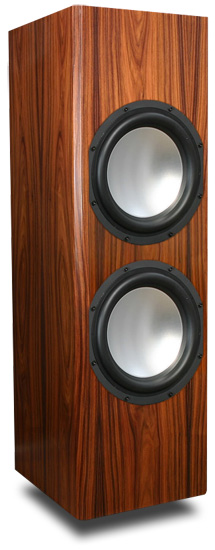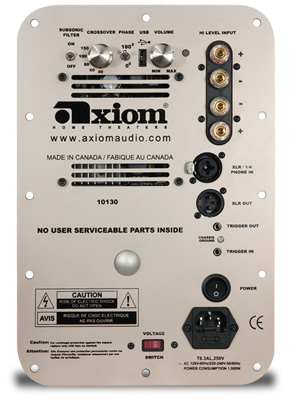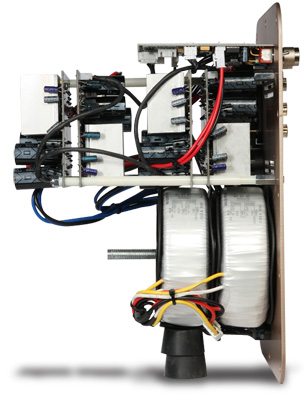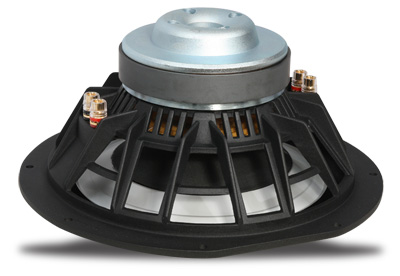 July 2010
Axiom
Audio EP800 v3 Subwoofer
  No matter what you listen
to -- movies or music, in two or many channels -- a subwoofer is a
likely addition to your audio system. Back in the old days, the most
prominent name in subwoofers was Velodyne; very few speaker
manufacturers had jumped into the fray. Nowadays, subwoofers are
more common than sunburns on tourists in
Hawaii,
and everyone makes models from the cheap to the expensive. But with
so many choices, separating the wheat from the chaff gets tougher
and tougher. No matter what you listen
to -- movies or music, in two or many channels -- a subwoofer is a
likely addition to your audio system. Back in the old days, the most
prominent name in subwoofers was Velodyne; very few speaker
manufacturers had jumped into the fray. Nowadays, subwoofers are
more common than sunburns on tourists in
Hawaii,
and everyone makes models from the cheap to the expensive. But with
so many choices, separating the wheat from the chaff gets tougher
and tougher.
One manufacturer of a whole gamut of subwoofers is Axiom Audio, an
Internet-based company located in Dwight, Ontario, Canada, in
cottage country three hours from Toronto. They’ve been around for 30
years now, making a complete line of speakers, amps, and subs. At a
base price of $2350 USD, the EP800 v3 is their most
expensive subwoofer.
Description
At 45.5”H x 15”W by 17”D and weighing 110
pounds, Axiom’s EP800 v3 is
the
biggest piece of audio gear I’ve ever had in my system. And it
dwarfed the small towers I used it with by more than a foot, which
made it look even bigger. (If the EP800 proves too imposing, Axiom
makes a horizontal version that can be placed behind a couch.) The
tapered cabinet is 15”W in the front and 12”W in the back. According
to Axiom, this shape acts to reduce standing waves inside. The edges
of the cabinet are chamfered to cosmetically match Axiom’s other
speakers, and also made it easier on my hands to move this beast
around.
Two 12” aluminum
cones
are centered vertically on the EP800 v3's front panel. Rather than one passive and one active cone, as is often seen
in other designs, both of these are driven by the EP800’s amplifier,
and have massive dual voice-coils for high power handling. The EP800
is a sealed design; there are no ports or openings anywhere in its
cabinet.
 The electronics consist of an Axiom-designed analog power supply and
digital amplifier rated at 800W RMS. Conventional digital switching
power supplies can distort when the amplifier demands large swings
of current; but with an analog power supply, the digital amp driving
the woofers has plenty of headroom for dynamic peaks, according to
Axiom. In addition, an XLF (for eXtended Low Frequency) DSP chip is
programmed to correct, within +/-1.5dB, any deviations from linear
response. In other words, the EP800 shouldn’t distort, no matter how
loud it’s cranked. The electronics consist of an Axiom-designed analog power supply and
digital amplifier rated at 800W RMS. Conventional digital switching
power supplies can distort when the amplifier demands large swings
of current; but with an analog power supply, the digital amp driving
the woofers has plenty of headroom for dynamic peaks, according to
Axiom. In addition, an XLF (for eXtended Low Frequency) DSP chip is
programmed to correct, within +/-1.5dB, any deviations from linear
response. In other words, the EP800 shouldn’t distort, no matter how
loud it’s cranked.
The control panel has speaker-level inputs, balanced XLR input and
output, 12V in and out triggers, a volume control, and a crossover
knob with a continuous range of 40-150Hz. The balanced XLR input
doubles as an RCA input, and Axiom provides an adapter to allow a
standard RCA interconnect to be plugged in. You can toggle the phase
from 0 to 180 degrees, and switch in a subsonic filter to cut off
the response below 20Hz.
I
received two different versions of the EP800. The first, from
Axiom’s custom VaSSallo Series, had a gorgeous finish of high-gloss
piano-black so shiny and smooth I could see my reflection in it.
This finish costs an extra $1150. Axiom also offers many real-wood
veneers in high, semi-, and low gloss, and can match any custom
finish. This level of customization is unprecedented for such
reasonably priced subwoofers and speakers. During the course of my
listening the EP800 underwent an updating, and Axiom sent me the new
version, the v3. This came finished in standard Black Oak, a
high-quality matte vinyl.
The v3 updates include cooling vents for the
amplifier, and a magnetically attached grille.
Design philosophy
 I’m
aware of three trends in the
pursuit
of deep bass: 1)
medium-size box, port, small amp; 2) small box, no port, big amp;
and 3) big box, no port, big amp. The reasoning behind each is
logical. The first type is the most common; a medium-size cabinet
needs a port to enhance its bass output, and can be driven with a
relatively small amp. The second type is the latest trend: small,
spouse-friendly subs that can be tucked into a corner, out of the
way. They can produce remarkable bass from their small, sealed
cabinets by driving the crap out of a small woofer with a big
amplifier. Often, they have two passive drivers to enhance bass
quantity. One of the design challenges of this type is that the
woofer has such long excursion that truly linear motion can be
difficult to maintain, and the result can be increased distortion. I’m
aware of three trends in the
pursuit
of deep bass: 1)
medium-size box, port, small amp; 2) small box, no port, big amp;
and 3) big box, no port, big amp. The reasoning behind each is
logical. The first type is the most common; a medium-size cabinet
needs a port to enhance its bass output, and can be driven with a
relatively small amp. The second type is the latest trend: small,
spouse-friendly subs that can be tucked into a corner, out of the
way. They can produce remarkable bass from their small, sealed
cabinets by driving the crap out of a small woofer with a big
amplifier. Often, they have two passive drivers to enhance bass
quantity. One of the design challenges of this type is that the
woofer has such long excursion that truly linear motion can be
difficult to maintain, and the result can be increased distortion.
The third and least common trend is putting a
big driver in a big box. This way, deep bass is achieved by virtue
of cabinet volume; the driver doesn’t have to move as much, and so
can be driven by a smaller amp. Axiom has taken this design approach
to an extreme in the EP800 v3, which achieves deep, subterranean
bass with a huge cabinet, huge amplifier,
and huge drivers!
Setting up
Because of the EP800’s sheer size, finding a suitable spot for it
can be problematic. I recently moved, and my new basement listening
room is 23’L x 16’W, with an average ceiling height of 8’. Because
my projection screen and main speakers are along the long wall, I
have lots of places along that wall to place a sub. I ended up
putting it in the front, about 7’ from the left sidewall, which gave
the EP800 plenty of room and no chance of interfering with my mains.
For the best blend of its output with that of the main speakers, the
EP800 should be paired with towers with some semblance of bass
response of their own. When I tried the EP800 with small on-wall
speakers, getting a seamless transition from speakers to sub was
challenging, to say the least. The best sound I had in my room was
with Monitor Audio’s Silver RX6, a small tower with decent bass
response down to 50Hz or so. I set the subwoofer crossover in my
Integra DTR-8.8 A/V receiver to 60Hz, to let the EP800 do its thing
below that frequency.
Performance
 I
played a few of my favorite CDs and was underwhelmed. Where was the
bass? I
played a few of my favorite CDs and was underwhelmed. Where was the
bass?
Folks, I almost fooled
myself. The EP800 v3 played in the subterranean ballpark, with
clean, tight bass that was true to the signals I fed it. On the
other hand, unlike most subwoofers, it didn’t exaggerate any
frequencies, especially in the upper bass. It didn’t add much to
some old rock tunes, like “Sunset Grill” from Don Henley’s
Building
the Perfect Beast (CD, Geffen GFN
224026), but once I’d listened to a few cuts of really deep bass,
all I could say was “Wow!”
The EP800 proved to be
the deepest-playing, most powerful subwoofer I’ve ever heard. I
pulled out a recording with the deepest bass I know:
Mussorgsky’s
Pictures at an Exhibition
and Stravinsky’s
Three Dances from Petrouchka, with
Jean Guillou performing his own transcriptions of these works for
pipe organ (CD, Dorian DOR-90117). I experienced wall-shaking bass
that rattled my light fixtures. During the frequent spates of the
lowest pedal notes, the movement of the air was incredible -- I
could feel it 10’ away! It is in these lowest notes that you feel
the music with your body more than you hear it in your ears.
Another album with decent
bass, though not in the lowest territory of organ music, is Holy
Cole’s
Temptation (CD,
Alert Z281026). The bass in such tracks as “Train Song” often sounds
overripe and boomy through many subwoofers and tower speakers. This
is one track that’s difficult to reproduce just right, and I often
use it when positioning main speakers and subs in my room. But with
its clean, tight bass, the Axiom excelled. Since the Monitor Silver
RX6 speakers don’t go very deep, the EP800 essentially filled in the
lowest notes without intruding on the upper bass, which made for a
formidable combination. The bass was tuneful, and it was easy to
distinguish individual notes plucked by bassist David Pilch’s deft
hands.
If I had any remaining doubts that the EP800 v3
was a fantastic subwoofer, they were laid to rest when I listened to
SuperBass 2,
a double-bass trio of Ray Brown, Christian McBride, and John Clayton
(SACD, Telarc SACD-63483). I didn’t know that three bassists could
be so melodic, but this disc is a superb demonstration of the
instrument. The EP800’s 12” drivers got quite a workout during “Papa
Was a Rolling Stone,” moving furiously to keep up with the music.
The deepest bass remained distinct and clear, with no muddying of
notes -- a gratifying performance that ranks with those put on by
the very best subwoofers I’ve heard.
Although the focus of
SoundStage! is two-channel audio,
but I’d be remiss if I didn’t mention how the EP800 v3 performed in
a home-theater system, since many buyers will use it for that
purpose. Once again, “Wow!” I was particularly impressed with its
reproduction of the low end of
Drumline.
In the extended, final showdown scene on the Blu-ray edition, the
percussion sections of the various marching bands battle it out --
this is one scene where you really want to crank up the volume. It’s
difficult for any system to reproduce the impact of the bass drum,
but the EP800 v3 came closer to that reality than I’d heard in my
room. Watching this scene, I could feel the air moving across my
legs. This sort of experience is the source of the audiophile term
pants-flapping bass.
The EP800 v3 provided a lot of it.
Comparisons
Although I didn’t have a single $2000 subwoofer on hand to compare
the Axiom EP800 v3 with, I did have two Definitive Technology
SuperCube IIs, which retail for $899 each. This made for an
interesting comparison: one huge sub vs. two tiny subs of the small
box, big amp type. The SuperCube II has one active 8” woofer driven
by a 1250W amp, and two passive 8” cones, all in a box whose largest
dimension is 12.5". Four SuperCube IIs can be stacked in about the
same amount of space occupied by a single EP800 v3. Was this a case
of Davids vs. Goliath?
Not quite. In most rooms, two subs will usually sound better than
one. That’s because bass frequencies will have peaks and nulls
throughout a room, and you may be sitting in a null. If so, no
amount of equalization will raise that null; no matter how much you
crank up your sub’s volume, your listening position will lack bass.
Unfortunately, my listening seat is in a bass-null region. Being
able to easily move two little SuperCube IIs around to various spots
in the room evened out the bass response so I could then fine-tune
it. In terms of décor, I’d have preferred to put the EP800 v3 in the
right front corner of my room, but that didn’t provide satisfying
bass at my listening seat. The final location was on the left side
of my room; satisfying, yes, but not a visually practical location
for the long term.
But even after I’d
optimized the positions of the SuperCube IIs, they couldn’t match
the sheer output of one Axiom EP800. When I watched the Blu-ray
edition of
Avatar, which
has tons of LFE effects, the impact and depth of bass from the Axiom
sub was a notch higher than from the Def Techs. Where the SuperCube
II combo worked better than the Axiom was with smaller speakers,
such as Definitive’s own Mythos XTR-50 on-wall model. The SuperCube
IIs’ smaller woofers were more adept at higher bass frequencies,
which made for a better blend with these smaller speakers. This was
evident on tracks such as the voices of Ladysmith Black Mambazo on
Long
Walk to Freedom
(SACD, Heads Up HUSA 9109). With this 5.1-channel disc, I found the
transition of voices from speakers to subwoofer less disjointed with
the SuperCube IIs than with the EP800.
Conclusion
If your room doesn’t offer placement flexibility, or is of medium
size or smaller, think carefully about the Axiom EP800 v3, or
consider some of Axiom’s smaller subwoofers. The EP800 really will
dominate a room, and its ideal location for bass output may not be
practical for you. I feel that two EP500 v2s, Axiom’s smaller but
still powerful DSP subwoofer, would be ideal for me.
But if you have a large room and you’re in the market for a
cost-no-object subwoofer, then give the Axiom Audio EP800 v3 a
listen. It competes with subwoofers that cost several thousand
dollars more, and might just save you a ton of money. And it will
provide extremely deep and powerful bass that takes a back seat to
no one.
. . .
Vince Hanada
vinceh@soundstagenetwork.com
|
Axiom Audio EP800 v3 Subwoofer
Price: $2350 USD.
Warranty: Five years parts
and labor.
Axiom Audio
Highway 60
Dwight,
Ontario
P0A 1H0
Canada
Phone: (866)
244-8796, (705) 635-3090
Fax: (705)
635-1972
Website:
www.axiomaudio.com
|
|

